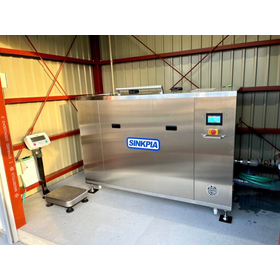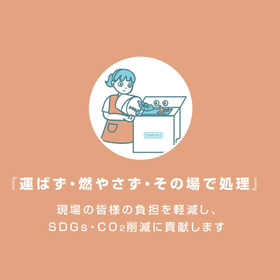【設置事例】伊勢市中学校給食共同調理場様
堆肥型や乾燥型と違い、原則取出しが不要!処理容量を超えない限り、追加投入が可能
三重県伊勢市中学校給食共同調理場様に業務用生ごみ処理機「シンクピア」 3台設置した事例をご紹介いたします。 今までは処理したものを取り出す必要がありましたが、約24時間程度で 生ごみを液化するため堆肥型や乾燥型と違い、原則取出しが不要。 また、処理槽内で生ごみ処理機専用の微生物が微生物担体に高密度に生息し、 適宜攪拌されることで生分解効率が向上、装置小型化が実現しました。 【事例概要】 ■導入先:三重県伊勢市中学校給食共同調理場 ■導入製品 ・業務用生ごみ処理機「シンクピア GJ-200」 ・業務用生ごみ処理機「シンクピア GJ-100」 ※詳しくはPDFをダウンロードしていただくか、お気軽にお問い合わせください。
基本情報
※詳しくはPDFをダウンロードしていただくか、お気軽にお問い合わせください。
価格帯
納期
用途/実績例
※詳しくはPDFをダウンロードしていただくか、お気軽にお問い合わせください。
関連動画
カタログ(4)
カタログをまとめてダウンロードおすすめ製品
取り扱い会社
【捨ててほしいのは、これまでの生ごみ処理機の常識】シンクピアの開発コンセプトは、生ごみを『運ばず・燃やさず・その場で処理』生ごみを施設内で自己処理することで、CO2削減・SDGSなどに貢献できる製品です。『燃やす』に頼り切っていた日本の生ごみ処理も転換期を迎え、生ごみ処理機業界は時代のニーズを捉え多くの企業が参入してきています。ですが、研究・開発などの費用面の問題や、知識・経験・技能の乏しさから多くの企業が撤退を余儀なくされてきた業界でもあります。すでに一部は実証実験をスタートさせていますが、生分解性の素材を用いた微生物ハウスの開発や汚れた生分解性容器を処理する装置の開発、さらに、分解水の液肥や土壌改良剤などの資源化にも着目して研究を進めています。私たちはより多くのお客様に必要とされ、これからの地球環境にやさしい社会を実現できる企業を目指していきます。
































































